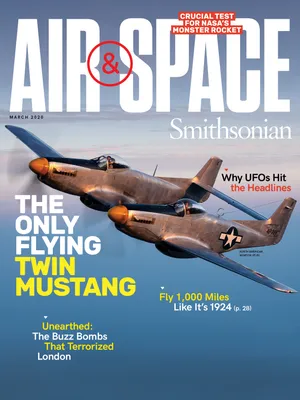A British Marine’s Jet Suit Turns its Pilot Into a Real-Life Iron Man
A former Royal Marines reservist hopes his invention will kick off a new kind of racing.
/https://tf-cmsv2-smithsonianmag-media.s3.amazonaws.com/filer/c4/50/c45099ff-0f3a-4d7f-9442-6c7e041c8ebf/32j_fm2020_richardbrowninghmsqe1creditdpphotos_live.jpg)
Last November, the aircraft carrier HMS Queen Elizabeth—the largest and most powerful ship ever to sail in the British navy—dropped anchor at Annapolis to host a transatlantic naval conference. But the $4.5 billion ship wasn’t the only remarkable spectacle that day: An unconventional pilot wearing a jet engine-powered suit launched himself into the air for a celebratory flyover.
The pilot was Richard Browning, a former Royal Marines reservist and oil trader, who founded a tech startup called Gravity Industries after spending several months developing the jet suit “for no reason initially other than just the sheer joy of the challenge,” he says.
While jet packs, rocketbelts, and their variants have been around for decades, Browning’s design stands apart in that its primary means of control is the human body itself. “The traditional kind of jet pack tends to be much more of a big kind of flight object that you’re strapping yourself into, whereas this is trying to be the most minimalist you can get away with in order to fly,” he says.
Browning’s suit is fitted with five small jet engines—two on each arm, one on the back—which collectively provide lift, and also a means for intuitive piloting. “There is some modest throttle control, but most of it is down to vectoring,” he says. “If you want to land, just flare your arms out…you drop because the vertical component of thrust has been diminished. And then to move forward all you’re doing is just deflecting the two forward front vectors, your arms, pointing them backwards. It’s a bit like the rotor disk of a helicopter.”
The jet suit can stay aloft for five minutes—and Richardson recently broke his own world speed record, achieving 85 mph. He is discussing potential military applications for the technology with the Royal Navy, but his bigger dream is to establish jet suit racing events, in the spirit of aviation pylon racing. A suit can be yours for a mere $440,000.
/https://tf-cmsv2-smithsonianmag-media.s3.amazonaws.com/accounts/headshot/mark-strauss-240.jpg)

/https://tf-cmsv2-smithsonianmag-media.s3.amazonaws.com/accounts/headshot/mark-strauss-240.jpg)